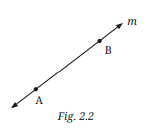NCERT Solutions for Class 6 Maths Chapter 2 Exercise 2.3 Lines and Angles - FREE PDF Download
FAQs on NCERT Solutions for Class 6 Maths Chapter 2 Lines And Angles Ex 2.3
1. What does Exercise 2.3 in Chapter 2 of NCERT Class 6 Maths cover?
Exercise 2.3 focuses on understanding different types of lines, such as parallel, intersecting, and perpendicular lines. It helps students learn how to identify and classify these lines.
2. How do NCERT Solutions help with Exercise 2.3?
The NCERT Solutions for Exercise 2.3 provide clear steps and explanations on how to solve problems related to lines. These solutions help students understand how to recognize and work with different types of lines accurately.
3. Can I download the solutions for Exercise 2.3?
Yes, you can download the NCERT Solutions for Class 6 Maths Chapter 2, Exercise 2.3 as a FREE PDF. This makes it easy to study and practice lines at your own pace.
4. What types of problems are included in Exercise 2.3?
Exercise 2.3 includes problems related to identifying and classifying different types of lines. Students practise recognizing parallel, intersecting, and perpendicular lines.
5. How do the solutions for Exercise 2.3 support learning?
The solutions offer step-by-step guidance on solving line-related problems. They help students understand how to classify lines based on their characteristics.
6. Are the solutions for Exercise 2.3 useful for homework?
Yes, the NCERT Solutions for Exercise 2.3 are very useful for homework. They provide detailed answers and methods that make it easier for students to complete their assignments accurately.
7. What should I do if I find a problem in Exercise 2.3 difficult?
If a problem is difficult, refer to the NCERT Solutions for Class 6 Maths Chapter 2, Exercise 2.3. The solutions offer clear steps and explanations that can help clarify the concept and solve the problem.
8. How can I practise the problems from Exercise 2.3?
Use the FREE PDF of NCERT Solutions for Class 6 Maths Chapter 2, Exercise 2.3 to practice problems. Follow the solutions to work through different types of line problems and improve your skills.
9. How do I know if I’ve solved a line problem correctly?
Check your answers against the NCERT Solutions for Exercise 2.3. The solutions provide correct answers and methods, allowing you to verify if your answers and steps are accurate.
10. What concepts are reinforced through Exercise 2.3?
Exercise 2.3 reinforces concepts such as identifying parallel, intersecting, and perpendicular lines. It helps students understand the properties of different types of lines.
11. How can I use NCERT Solutions to prepare for tests?
Review the NCERT Solutions for Class 6 Maths Chapter 2, Exercise 2.3 to understand how to solve line problems. Practice using the solutions to prepare for tests and ensure you understand the material well.
12. Are there any tips for solving problems in Chapter 2 Exercise 2.3?
Yes, read each problem carefully and pay attention to the characteristics of lines. Refer to NCERT Solutions for tips on identifying and classifying lines to solve problems correctly.
13. How often should I review Exercise 2.3 NCERT solutions?
Regularly review the NCERT Solutions for Class 6 Maths Chapter 2, Exercise 2.3 to reinforce your understanding of lines. Regular practice will help you become more confident and accurate in solving line problems.


















